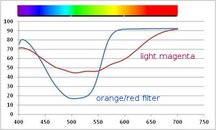That phenomena is a consequence, not the cause.
I'm sharing here my plot on the visible wavelength absorption profile of two materials, I can not disclose the manufacturer. The horizontal axis are the wavelengths (I added a color scale on top) and the vertical axis is the % absorbed.
View attachment 143967
The red line is a very light MAGENTA filter, the blue line a darker ORANGE/RED filter. Just to clarify, these are not IDEAL color profiles for UW color correction, and that's why I'm sharing it

The "dip" is proportional to the amount of coloring agent added to the resin, so the more magenta or red, it will INCREASE that absorption and consequently DECREASE the amount of light reaching the sensor (proportional to the area below the line, if you integrate the % and wavelengths). These are just two materials, different color combinations will produce different profiles, some will "dip" deeper, some will sacrifice some of the oranges and so on. I prefer not to mix color temperature (kelvin) on discussing filters.
Now for the reason why one color "cancels the other" is that our eyes (and the camera sensor) see what is NOT absorbed by the material when the light bounces of it. We see a leaf green because it absorbed most of all other colors leaving only green. This red filter, for example, is red/orange because it absorbs most of the green/blue wavelenghts and reflects (or lets through) the red/orange that we see.
My grudge with these PolarPro filters is that the people that make them apparently are NOT versed in the science behind it or have the diving/UW photography background - they just jumped on the boat and decided on colors just by looking at them, seemed like a profitable business. Judging by the color on their snap-ons and the color of materials and their absorption curves (as above), they seem to be TOO aggressive in absorbing color, that is, the curve "dip" is too deep, leaving little light left for a camera that we know does not perform well in low light (thus the murky look). The fact that they sell color filters for the Hero/Hero2 STOCK housing is a proof - if you ever used the stock housing in water, you would know that it does not focus so why bother having filters? Even for the Hero Dive Housing and the Hero3, having a filter that requires unscrewing the lens does not look like a smart decision, not one someone that actually dives would do. I will take all back once I'm proved wrong.
I do not own any URPro filters but have look at materials that are pretty close to their colors and can tell (visually) that they got it right. These here are might be also worth checking out, they both seem to have done their research:
Amazon.com: GoPro HERO3 Red Filter (BG) - Dive Diving Underwater Color Correction: Camera & Photo 





